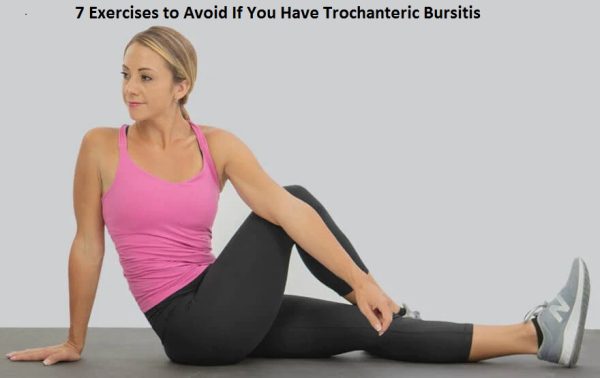If you suffer from Trochanteric Bursitis, you know how painful it can be. In this blog post, we’ll discuss 7 exercises to avoid if you have Trochanteric Bursitis. Exercises that aggravate the condition can make the pain worse, so it’s important to know which exercises to avoid in order to manage your Trochanteric Bursitis. Read on to learn more about the exercises to avoid and how to manage your condition.
1) Leg Lifts
Leg lifts are a popular exercise for toning the leg muscles, but unfortunately, they can be a big no-no for people suffering from trochanteric bursitis. This is because the movement can put pressure on the bursa located near the hip joint, causing pain and inflammation. It’s important to avoid these exercises as the hip area is already in pain due to the bursitis.
If you have trochanteric bursitis, leg lifts can be replaced by other low-impact exercises such as swimming, cycling or using an elliptical trainer. These exercises will strengthen your legs without aggravating the bursitis. Alternatively, you can opt for gentle stretching exercises like yoga or tai chi to improve your range of motion and reduce tension in your hip muscles.
Related Articles: Trochanteric Bursitis Causes, Symptoms, Diagnosis and Treatment
2) Sit-Ups
Sit-ups can be a challenging exercise that involves engaging many muscles in your core. Unfortunately, they can also be a major cause of aggravating your trochanteric bursitis. This is due to the added pressure that is placed on the hip area when performing this exercise. For this reason, it is important to avoid sit-ups if you suffer from trochanteric bursitis. Instead, you should look for alternative exercises that can help to strengthen your core without putting added stress on your hips. Examples of these exercises may include planks, Russian twists, and bird-dogs.
3) Leg Curls
Leg curls are a great way to strengthen your lower body, but they can also put a strain on your hip joints and cause pain in the trochanteric bursa if done improperly. If you have trochanteric bursitis, it is best to avoid leg curls as this type of exercise can easily overwork the affected area and make the condition worse.
If you want to strengthen your lower body muscles without putting too much strain on the trochanteric bursa, try exercises like bodyweight squats and glute bridges instead. These exercises put less pressure on the hip joints while still providing a great workout.
4) Hamstring Stretches
When it comes to trochanteric bursitis, hamstring stretches should be avoided. This is because stretching the hamstring can put too much pressure on the bursa, causing inflammation and discomfort. Instead of stretching your hamstring muscles, opt for other activities such as gentle walking or cycling.
Stretching your hamstrings can also cause muscle tears or strains, which could aggravate the bursitis even more. To prevent further damage to the hip joint, it’s best to stick to low-impact exercises such as swimming or yoga. These activities don’t put as much strain on your hip joint and can help you maintain mobility.
If you still feel like you need to stretch your hamstrings, try dynamic stretching instead. Dynamic stretching is a more active form of stretching that involves moving through the range of motion instead of holding the stretch. This type of stretching increases flexibility while decreasing risk of injury. So if you’re looking to increase your range of motion, dynamic stretching might be a better option than static stretching.
5) Running
Running is a great way to get exercise and stay in shape, but it can also be a major risk factor for those suffering from trochanteric bursitis. The constant impact of the feet hitting the ground combined with the repetitive motion of running can put too much pressure on the bursa located near the hip joint. This can lead to an increased risk of inflammation and pain.
If you’re suffering from trochanteric bursitis, it’s best to avoid running until the condition has healed. In some cases, however, low-impact running may be recommended by your doctor or physical therapist as part of your rehabilitation program.
If your doctor has given you the okay to run, it’s important to follow these tips:
- Warm up thoroughly before running with light stretching and jogging.
- Make sure your running shoes are supportive and in good condition.
- Try to avoid running on hard surfaces and opt for softer surfaces like grass or dirt.
- Run at a slower pace than usual and take more frequent breaks.
- Use an over-the-counter anti-inflammatory medication before running to reduce inflammation and pain.
If you experience any pain while running, stop immediately and consult your doctor or physical therapist.
6) Lunges
Lunges are a great exercise to work your legs and glutes, but they can also be very dangerous if you suffer from trochanteric bursitis. This is because lunges involve the hip flexors and can aggravate the bursa, which can cause inflammation and pain.
The best way to avoid this is to focus on alternative exercises that don’t involve the hip flexors. For example, wall squats and step-ups can be effective in strengthening the lower body while avoiding irritation of the bursa.
Another alternative to lunges is the lateral lunge. To do this, stand with feet shoulder width apart and take a big step out with one leg. Bend your knee and lower yourself towards the ground, pushing your hips back and keeping your weight in the heel of your foot. Push back up to standing position, bringing your feet together and repeating the same motion on the other side.
Overall, it is important to avoid any exercises that involve the hip flexors when you have trochanteric bursitis, such as lunges. If you are looking to strengthen your lower body, alternatives such as wall squats, step-ups, and lateral lunges can be beneficial while avoiding further inflammation of the bursa.
7) Hiking
Hiking is a great way to get outdoors and enjoy nature, but for those with trochanteric bursitis, it can be an activity that worsens their condition. When hiking, the body’s weight is supported by the hips and legs, causing a significant amount of pressure to be put on the hip joints. The repetitive nature of walking on uneven surfaces also can increase irritation of the bursa and further worsen pain.
To reduce the risk of further inflammation or injury, those with trochanteric bursitis should avoid hiking until their condition has improved and they have received clearance from their doctor or physical therapist. If you do decide to hike, make sure you take frequent breaks and pay attention to any signs of increased pain or discomfort. It is also important to wear supportive shoes with good arch support. Additionally, try to stay on flat trails as much as possible to reduce stress on the hips.




